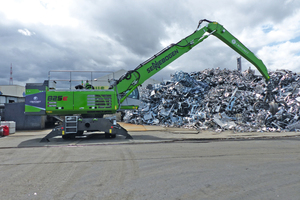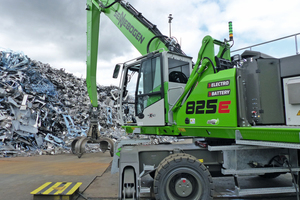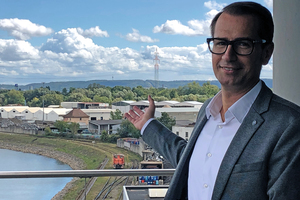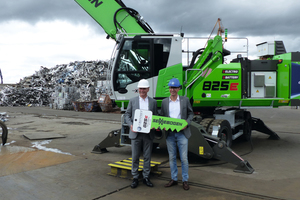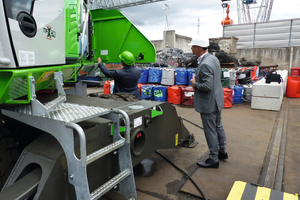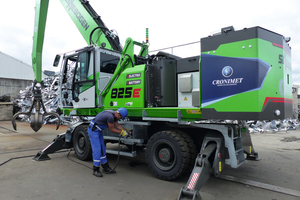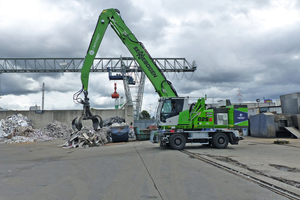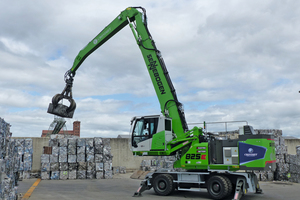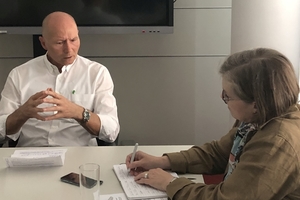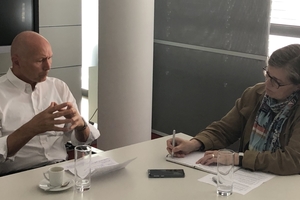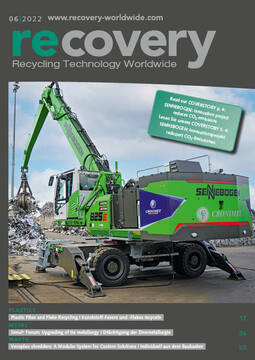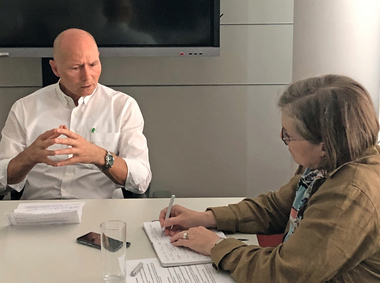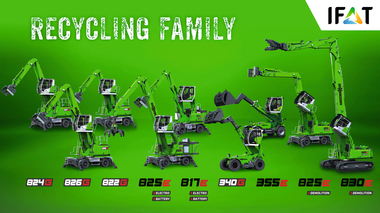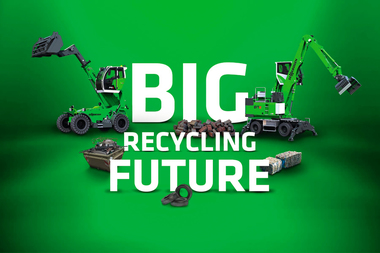SENNEBOGEN hands over first battery-powered material handler 825 Electro Battery to cooperation partner CRONIMET
To maximize the reduction of CO2 emissions in the recycling process, SENNEBOGEN has cooperated with its key account CRONIMET to develop the 30-t electric material handler 825 Electro Battery with battery-powered operation. Zero-emission operation is thus enabling a sustainability approach in the recycling process itself that goes beyond the return of valuable resources into the circular economy.
Visit to Karlsruhe Rhine Port. The occasion was the handover of the key for the commissioning of the first battery-powered SENNEBOGEN 825 Electro Battery material handler by Managing Director Erich Sennebogen to the company CRONIMET Ferroleg. GmbH. This symbolic moment took place on the works site of the Karlsruhe-based stainless steel recycling specialist, a long-standing partner of SENNEBOGEN, the manufacturer of material handlers based in Lower Bavaria.
Objective of the innovation project was to reduce the CO2 emissions in the recycling process in order to enable zero-emission operation.
Back in spring, SENNEBOGEN had premièred the 817 Electro Battery as the first model of this new machine concept at IFAT 2022. As an addition to SENNEBOGEN’s line of electric machines, a battery-powered electric material handler maximizes CO2 reductions while simultaneously extending flexibility thanks to its cable-free freedom of movement.
As a sort of “big brother” to the SENNEBOGEN Electric Material Handler 817 Electro Battery with 9 m reach and 18 t operating weight, the 825 is now taking over at the top end of the power range with an operating weight of around 30 t and 14 m reach. With its reach and operating weight, it is based on the SENNEBOGEN 825 E with 110 kilowatt electric motor. Instead of the counterweight at the rear, a lithium ion battery with a storage capacity of 378 kilowatt hours is installed that allows the material handler to be operated for up to 8 hours without any need for recharging. The intelligent Dual Power Management enables autonomous working in battery powered mode as well as when the handler is connected to the mains. This also allows working and charging at the same time. Here, the battery is recharged with any excess fed-in power. Additional investment in charging stations is not necessary as, thanks to the onboard charger and the 63A CEE plug system used, the battery can be connected to conventional industrial power sockets.
In comparison with existing solutions, CO2 emissions can be reduced by 125 t per year.
Moreover, the SENNEBOGEN electric material handler 825 Electro Battery offers the operators greater comfort as it works with less noise, lower vibrations and absolutely zero emissions.
Innovation cooperation with CRONIMET
SENNEBOGEN and CRONIMET have been cooperating since back in 2014. CRONIMET Ferroleg. GmbH is part of a globally operating group of companies in metal recycling and trade, which in 2021 returned 140 000 t stainless steel scrap and other alloy scrap to the economic cycle at its base in Karlsruhe. Nine material handlers are deployed at the Karlsruhe facility for sorting at goods receipt, at the scrap baler and the chip crusher as well as for loading.
The CRONIMET Group with 68 sites on six continents has pledged to achieve CO2-neutral operation by 2030.
“We haven’t just nailed our colours to the mast with our pledge to become CO2 neutral, we actually want to realize this in practice. We have been working intensively on this for years,” says Marijo Zeljko, Managing Director at CRONIMET Ferroleg. GmbH. He explained how the company had therefore begun switching its forklifts to electrically powered machines. This switchover is currently being extended to include other machines like handlers and locomotives. Two years ago, the first roof in Karlsruhe was fitted with solar panels. In the meantime, there are 40 charging points for electrically powered cars at Karlsruhe, combined with an intelligent system in which all charging stations communicate with each other. Power peaks when the large consumers such as chip crusher and press are connected to supply are offset by the charging power for the cars being reduced.
„We are ready to take small as well as big innovation steps and want to show that it is possible to decarbonize the recycling of metal scrap,” says Marijo Zeljko.
The current cooperation with SENNEBOGEN is another important project on the way to that goal, not least because the size of the material handler makes it an innovation challenge. Moreover, the project has been supported by Germany’s Federal Ministry for Economic Affairs and Climate Action.
In use at different stations, but also to cope with changing material streams, the material handlers need to demonstrate a relatively high degree of flexibility. Thanks to its flexibility, and particularly being able to work without a cable connection, the handler can easily react to changes to schedules at goods receipt or in production.
CRONIMET has contributed to the product development by channelling its extensive practical know-how into it, for instance with intelligent additions to the battery technology, but also with participation at the prototype stage.
At the time of the key handover, the SENNEBOGEN electrically powered material handler 825 Electro Battery was completing a test run on the CRONIMET site at Karlsruhe Rhine Port, before being taken to Munich to be presented to the public as one of a total of 13 machines on display on the SENNEBOGEN stand at bauma 2022.
recovery: What’s special about the SENNEBOGEN 825 Electro Battery material handler? What machine concept does it involve?
Erich Sennebogen: We have redevised the concept of this machine. The trigger was naturally the general trend of going CO2 neutral. This is the task we have set ourselves. With CRONIMET, we have found a partner with whom we have discussed a lot of different aspects and who then also said that the 30-tonne handler is the right machine. In addition, we have also developed the somewhat smaller 817 and considered key features in the scope of the project. First, a relatively high battery power so that we really can run the machine in normal operation for eight hours. For many applications, it is very important that you have the right size of battery pack. Another important aspect is that the machine can be charged while the handler is working, and that is via the undercarriage. Then we have chosen a high-quality battery that offers maximum safety also with regard to the fire hazard. Moreover, we have built the battery-powered machine on the same basis as our electrically powered machine. That means identical maintenance, identical service and identical replacement parts. A key factor with regard to safeguarding the maintenance of this machine.
recovery: When did you start making these battery-powered electric machines?
Erich Sennebogen: It’s a new development. We started with the project around one and a half years ago, held talks, compiled a specification sheet with our sales team and asked ourselves what would our customers want? From this, we developed the concept, and parallel to this we installed a high-voltage engineering group within our company that specializes on this topic. The first machine to be evolved from this is the 817, a 19-tonne machine that we premièred at IFAT 2022. Parallel to this, we have also developed the 825, a 30-tonne machine. Both models were tested intensively on our test site, the 825 is currently undergoing interim testing at CRONIMET. This machine also went to bauma. bauma has been the première for the battery-powered 825. We are now producing the 817 and 825 with battery parallel and have set a number to be manufactured for next year. We’ll see how the market responds. In the range from 19 to 30 tonnes, these will then go into series production. At present we have two models, we are, however, further developing in the background. New components are coming on the market. Improved versions of the batteries. There is a lot going on in this segment and you really have to stay on the ball right now.
At the moment, you can’t really talk about market leadership. One or the other company is presenting or making such a battery-powered machine, but the question is, however, how many will be effectively launched on the market. For this year, we can’t really gauge the situation, by the end of next year, I will definitely be able to say more.
When it comes to electrically powered machines, we shall certainly launch the most machines on the market because we have produced and pressed ahead with developing machines that are electrically powered via a mains cable for over 30 years. Here, we have stand-out expertise in consulting and execution. 30 years ago, we equipped primarily the stationary machines with electric motors and therefore we have many years of experience and many machines in field operation.
recovery: Is more of the product range to be switched to battery-powered equipment?
Erich Sennebogen: That’s something the market will tell us. Of course, you shouldn’t forget that a battery-powered machine costs twice what a normal machine will put you back. In addition, many investments in this area are naturally subsidized at the moment. This makes it easier for customers to decide to invest in such a machine. That is not only the case in Germany, but also in Switzerland and other countries. You have to look at how long the subsidies will remain available. As without these, it will be difficult for any cannily calculating company to afford such a machine because it will then have to take double the hourly rate as a basis for its calculations.
The battery-powered machine requires a certain enthusiasm, a vision of CO2 neutrality. You have to scrutinize your company to see where it can be optimally deployed. It is no straight substitute for a diesel-powered machine, you have to rethink and optimize internal workflows and logistics. Here, too, we can advise our customers, channelling our experience and ideas into potential solutions.
recovery: In any case, it is easy to see how enthusiastic you are. Every company has to develop its own sustainability concept. What does the SENNEBOGEN sustainability concept look like?
Erich Sennebogen: The first aspect is the sustainability of our products, that means, naturally, electric power and batteries, that means improving the efficiency of the machines based on hybrid systems, which we also have in our range. Compared with conventional machines, it is demonstrably possible to save 70 % of the energy and maintenance costs. That are all concepts that you have to elaborate with the client.
The second, of course, is sustainability within our company. Here, we are doing a great deal: photovoltaics, wood chip heating, just at the Wackersdorf plant, we have 1 megawatt wood chip heating. We are constantly expanding our photovoltaic systems and we work with battery storage so that we can store power so we can use it then when we need it. All lighting has been switched to LED, we are thinking about HVO fuels for our internal fleet. We shall continue working on this by the end of the year in order to move away from diesel.
You also have to ask what CO2 savings we have already achieved and what we still aim to achieve? This includes a substantial reduction in CO2 and, perhaps by 2030, CO2 neutrality. Environmental protection costs money and you need resources in the company. But we are family company and as such we do think about the environment and what comes after. Our offices are not cooled with air-conditioning systems, but with ground water, which is then recirculated.
As an entrepreneur, you do have to do a so-called environmental audit to show what you have achieved and where you still have deficits. All buildings erected over the last five years have been built to KfW-55 standard, that is with increased thermal insulation. All buildings have concrete core activation, i.e. underfloor heating, in the production halls, too, because that is the best and most effective heating.
recovery: How do you see Germany as a base for business? What markets are currently particularly important for you?
Erich Sennebogen: We have two companies in Hungary. Two welding companies. One very successful since 1996, and recently we have built a second plant to get more inhouse structural steel expertise and capacity. In Hungary, it is just as difficult to find good people. Unfortunately, it’s the same story almost all over Europe.
Key markets for us are Germany and Europe, of course. We were strong in Russia, but that market no longer exists. Very important are the USA; there we have our own company with just under 100 employees. Asia and Africa have potential if you look at material handling, but they’re not exactly huge markets. We are also represented with our own company in Singapore and from there we support the Asia-Pacific region. These markets are not yet quite so prominent, but are playing an increasingly important role for us. We have dealers there and are trying to develop the market. New Zealand is a good market for us. We are essentially represented worldwide because our clients are, too, as you can see from CRONIMET.
recovery: Are there strategies for the future?
Erich Sennebogen: In the last five years, we have made some extremely large investments. Our new Customer Service Center on the motorway at which we centrally pooled our customer service and replacement part supply, the new structural steel engineering plant in Hungary. We have also invested in the steady expansion of our plants. Something I am particularly proud of: Our new development and technology centre. A new office building to house design, control engineering and accounts with workshop laboratory. Directly next to it is a testing facility in which we test and optimize prototypes with our own testing crew. We live on technology, innovation, and fantastic products for our customers. The trend is heading in the direction of technology, innovation, further diversification with different drive units, stocking up on corresponding specialists. At present, we have the highest personnel level with over 2000 employees in the entire group. We want them to feel comfortable with us. We want to make the office building an even nicer place to be than the people’s own homes. We also offer home-office and flexible working times, but we need people to be in the office. That is where innovation and group dynamics are sparked, where exchange between sales, engineering and production takes place. This is essential for what we do. We are not a manufacturer of large series of machines that develops something and then builds thousands of copies of it. We are an individualist, we have our series machines, but we have specialist machines, customer orientation and custom solutions. That’s one of our strengths.
recovery: The handing over of the key, a symbolic act that you do for every machine?
Erich Sennebogen: We don’t quite manage that, but we do like doing it. And our sales people, dealers and partners like it, too. We send the client a key, or one of our sales reps goes out to them. At bauma, we handed over some more machines. I find it good, along with the client, the key connects us. A nice gesture that we have been doing for 15 years and that has often been copied since.

